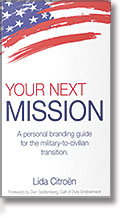 |
||||||||||||
|
Economic Opportunities Committee Report, July/August 2014 Veterans in Transition BY FRANK BARRY, CHAIR
The U.S. Department of Labor has been attempting to help by having returning veterans attend Targeted Assistance Program workshops. Having attended a TAP workshop, I can attest that it is merely a cursory attempt at helping veterans make the transition. Each veteran is given a book—The Military to Civilian Transition Guide—which covers such topics as identifying skills, interests, and values; conducting research; creating dynamic resumes and letters; networking; and negotiating salaries and benefits.
How does a veteran build a personal brand? First, take a look at your current brand, the reputation that you have built in the minds of other people. Second, take inventory of what inspires you; what skills you are known for; what skills you are good at; what skills, talents, or credentials you are missing; and what motivates you. Third, articulate your desired brand—the legacy you hope to leave. Fourth, set the vision of your goals. Fifth, solicit and encourage honest feedback. Sixth, understand your target audience and your competition. Important topics about understanding the transition include career myths, reasons for hiring a veteran, the corporate culture, trust, Hollywood misconceptions of veterans, and civilian careers outside the corporate structure. Citröen’s final chapter includes valuable job search tools (business cards, resumes, cover letters); positioning oneself for success (building an intentional network of contacts, building credibility by telling people what you believe in and what you value, positioning yourself as a subject-matter expert or valuable connection), research and preparation (researching the company and its staff, checking the company’s LinkedIn page, conducting in-person follow up with the people you know and asking for an informational meeting, having notes and questions ready from the research), and the job interview (reviewing standard candidate interview questions, image and dress, what to bring to the interview). There are many resources available. Sharing them will help many veterans make that transition. The Economic Opportunities Committee will continue to work to ease the transition of those coming home.
|
||||||||||||
|
|
||||||||||||
|
||||||||||||
8719 Colesville Road, Suite 100, Silver Spring. MD 20910 | www.vva.org | contact us |
||||||||||||









 One of the most difficult tasks for veterans returning to the civilian workforce is how to present themselves and their experiences in a way that makes civilians understand that veterans have what it takes to help a business be successful.
One of the most difficult tasks for veterans returning to the civilian workforce is how to present themselves and their experiences in a way that makes civilians understand that veterans have what it takes to help a business be successful. A more recent resource is a book by Lida Citröen,
A more recent resource is a book by Lida Citröen,